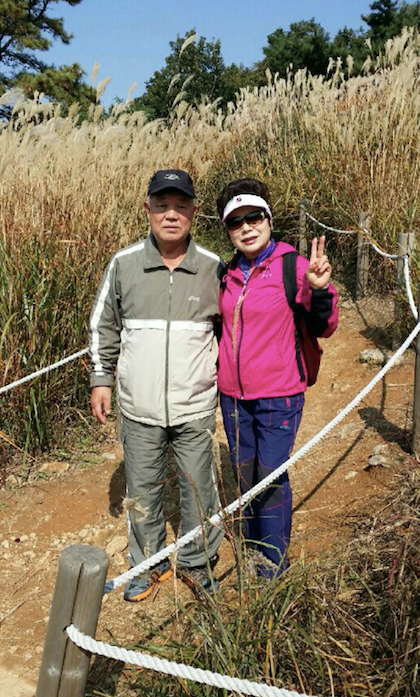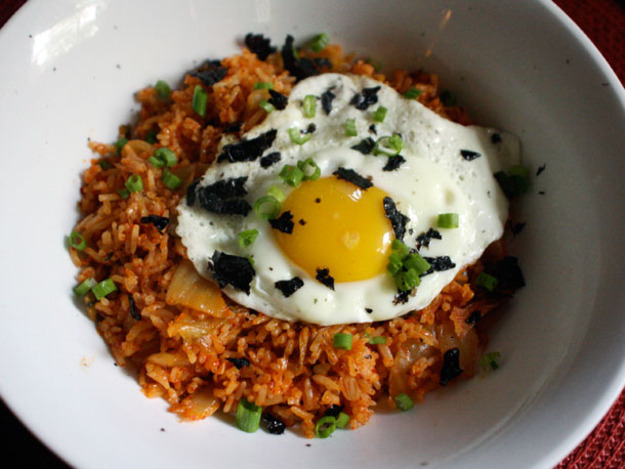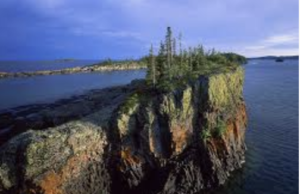Korean women first expected to live over 90

Gyu Yongju, pictured left, and husband Kim Mando, pictured right, at Seoraksan National Park on Oct. 22, 2017.
As medical technology continues to advance, life spans in the world’s wealthiest countries will continue to increase, and South Korean women may be the first to live longer than 90 years on average.
South Korea has seen remarkable transformation over the past 70 years from an impoverished war-torn nation to a leader in technology, business and now lifespan. As recently as the mid-1980s, life expectancy for South Korean women was less than 75, while men could not expect to make 65.
A new study published by the The Lancet showed that South Korean women have a 57 percent chance of hitting the over-90 longevity mark. The surest bet was that they would exceed age 86 on average.
The study combined 21 different forecasting models for age-specific mortality to 2030 in 35 industrialized countries with high-quality vital statistics data. South Korea also led the list for longevity in men, as they were expected to live beyond 80 on average.
So what is the secret? On this, there is some consensus: investments in medical care, a health-conscious culture and a hearty diet underpinned by the ubiquitous presence of fermented vegetables, most notably kimchi.
“I think I’m doing OK for my age,” Yongju, a 87 year old Korean woman said. “I go hiking at least twice a week. It’s important to stay fit and active. Also, eat your kimchi!”
But the nation has a cultural obsession with feeling its own pulse. Many South Koreans will readily confess to suffering from “health anxiety,” visiting a doctor for the slightest of symptoms.
“I visit my doctor frequently, maybe once a month, and he helps me with all my problems. I’ve never thought that it was too much,” Yongju said.
One study last year found that only 35 percent of Koreans believe they are in good health, the lowest in the OECD, the Paris-based club of mostly rich nations, and the phenomenon is underscored by TV shows offering medical advice, the number of which regulators deemed “incalculable.”
The health benefits of all this hypochondria are clear. The Imperial study lauds South Korea’s efforts to check hypertension, obesity and chronic diseases. These advances, however, were only made possible by the government’s longstanding commitment to universal healthcare. Under the system, the vast majority of citizens pay a national health insurance premium deducted from their paychecks.
Patients over 40 have a free medical check-up every two years, and the cost of visiting a doctor is drastically reduced — an incentive that has increased early detection of disease.
Americans facing health crisis, one of lowest life expectancies of first world countries
When compared to other wealthy countries, the United States has a very low life expectancy. American men and women are in 23rd and 27th places, respectively, in terms of life expectancy on the Lancet study, and they were expected to fall farther as other countries, particularly in Eastern Europe, improve.
For the first time since the 1990s, Americans are dying at a faster rate, and they’re dying younger. The overall death rate rose by 1.2 percent in 2015, the first time since 1999.
A pair of new studies suggest Americans are sicker than people in other rich countries, and in some states, progress on stemming the tide of basic diseases like diabetes has stalled or even reversed. The studies suggest so-called “despair deaths”—alcoholism, drugs and suicide — are a big part of the problem, but so is obesity, poverty and social isolation.
Although the United States has advanced medicine, it has an obesity epidemic, little focus on preventive care, relatively high mortality among babies of uninsured mothers and high male death rates from gunshot wounds and car accidents.
American life expectancy fell by one-tenth of a year since 2014, from 78.9 to 78.8, according to a report released last week by the National Center for Health Statistics. As The Washington Post reported, the last time the life expectancy went down instead of up was in 1993, during the throes of the AIDS epidemic.
For those trying to figure out how long you’re likely to live, estimates of “average” life expectancy may not be that helpful because that’s getting worse in an age of rising inequality. Great medical care and good fortune may add decades to the lives of the wealthy and educated, while much of the rest of America is left behind.
Korean recipes
Baechu, or napa cabbage, kimchi is made by lacto-fermentation, the same process that creates sauerkraut and traditional dill pickles. In the first stage the cabbage is soaked in a salty brine that kills of harmful bacteria . In the second stage, the remaining lactobacillus bacteria (the good bacteria) convert sugars into lactic acid, which preserves the vegetables and gives them that wonderful, tangy flavor.
Cabbage Kimchi

Ingredients and Materials:
1 medium head (2 pounds) napa cabbage, ¼ cup sea or kosher salt, Water , 1 tbsp grated garlic (5 to 6 cloves), 1 tsp sugar, 1 to 5 tablespoons , Korean red pepper flakes (gochugaru), 8 ounces Korean radish or daikon, peeled and cut into matchsticks, 4 scallions trimmed and cut into 1-inch pieces, Cutting Board and knife, Large bowl, Gloves, Plate and something to weigh the kimchi down, like a heavy jar or can of beans , Colander, Small bowl, Clean 1-quart jar with canning lid or plastic lid, Bowl or plate to place under jar during fermentation
Instructions:
- Slice the cabbage. Cut the cabbage lengthwise into quarters and remove the cores. Cut each quarter into 2-inch wide strips
- Salt the cabbage. Place the cabbage and salt in a large bowl. Using your hands, massage the salt into the cabbage until it starts to soften a bit, and then add just enough water to cover the cabbage. Put a plate on top of the cabbage and weigh it down with something heavy like a jar or a can of beans. Let it be for one to two hours.
- Rinse and drain the cabbage. Rinse the cabbage under cold water three times and drain in a colander for 15 to 20 minutes. Rinse and dry the large bowl you used for salting and set it aside for later.
- Make the paste. Meanwhile, combine the garlic ginger, sugar and 3 tablespoons of water together in a small bowl and mix to form a smooth paste. Then, mix in the gochugaru using 1 tbsp for mild and up to 5 tbsp for spicy, (I like about 4 tablespoons, so I don’t hurt myself).
- Combine the vegetables and paste. Gently squeeze any remaining water from the cabbage and return it to the bowl along with the radishes, scallions and seasoning paste. Using your hands, gently work the paste into the vegetables until they are thoroughly coated.
- Pack the kimchi into a jar. Pack the kimchi into the jar, pressing down on it until the brine rises to cover the vegetables. Leave at least 1 inch of headspace and seal the jar with the lid.
- Let it ferment. Let the jar stand at room temperature for 1 to 5 days. You may see bubbles inside the jar and brine may seep out of the lid; place a bowl or plate under the jar to help catch any overflow.
- Check daily and refrigerate. Check the kimchi once a day, pressing down on the vegetables with a clean fingers or a spoon to keep them submerged under the brine. (This also releases gases produced by the fermentation.) When the kimchi tastes ripe enough to your liking, transfer the jar into your fridge. It’s OK to eat right away, but it’s best after another week or two.
Kimchi Fried Rice

Ingredients and Materials:
3 cups steamed rice, 1 cup chopped kimchi, ¼ cup kimchi juice, ¼ cup water, 2-3 tablespoons, gochujang, 3 teaspoons sesame oil, 1 teaspoon vegetable oil, 1 green onion (chopped), 1 tablespoon roasted sesame seeds, 1 sheet of nori seaweed, roasted and shredded, 2 eggs, 1 large fryng pan, 1 small frying pan, Kitchen knife, Spatula, Wooden spoon
Instructions:
- Oil the pan and add onions. In a nonstick sauté pan or well-seasoned cast-iron skillet, pour in vegetable oil over medium-low heat and add onions. Cook, stirring with a wooden spoon, until the onions start to sizzle for about 2 minutes.
- Add the kimchi and some kimchi juice.To get kimchi juice just get the watery content of your kimchi jar. Stir until the rice comes to a boil.
- Break up the rice in the pan with a spatula, and stir it to incorporate. Turn heat to medium. Cook, stirring, until the rice has absorbed the sauce and is very hot, about 5 minutes.
- Stir in soy sauce and sesame oil. Taste, and adjust with more soy sauce, sesame oil or kimchi juice. Turn heat down slightly, but let the rice continue to cook, untouched, to lightly brown.
- Meanwhile, fry an egg on another pan. Grease the pan with bit of sesame oil and let the egg on the pan be for minute or so. Sunnyside is usually the best way to eat an egg on the kimchi rice.
- Serve rice topped with fried eggs, nori and a sprinkle of sesame seeds.









You must be logged in to post a comment Login